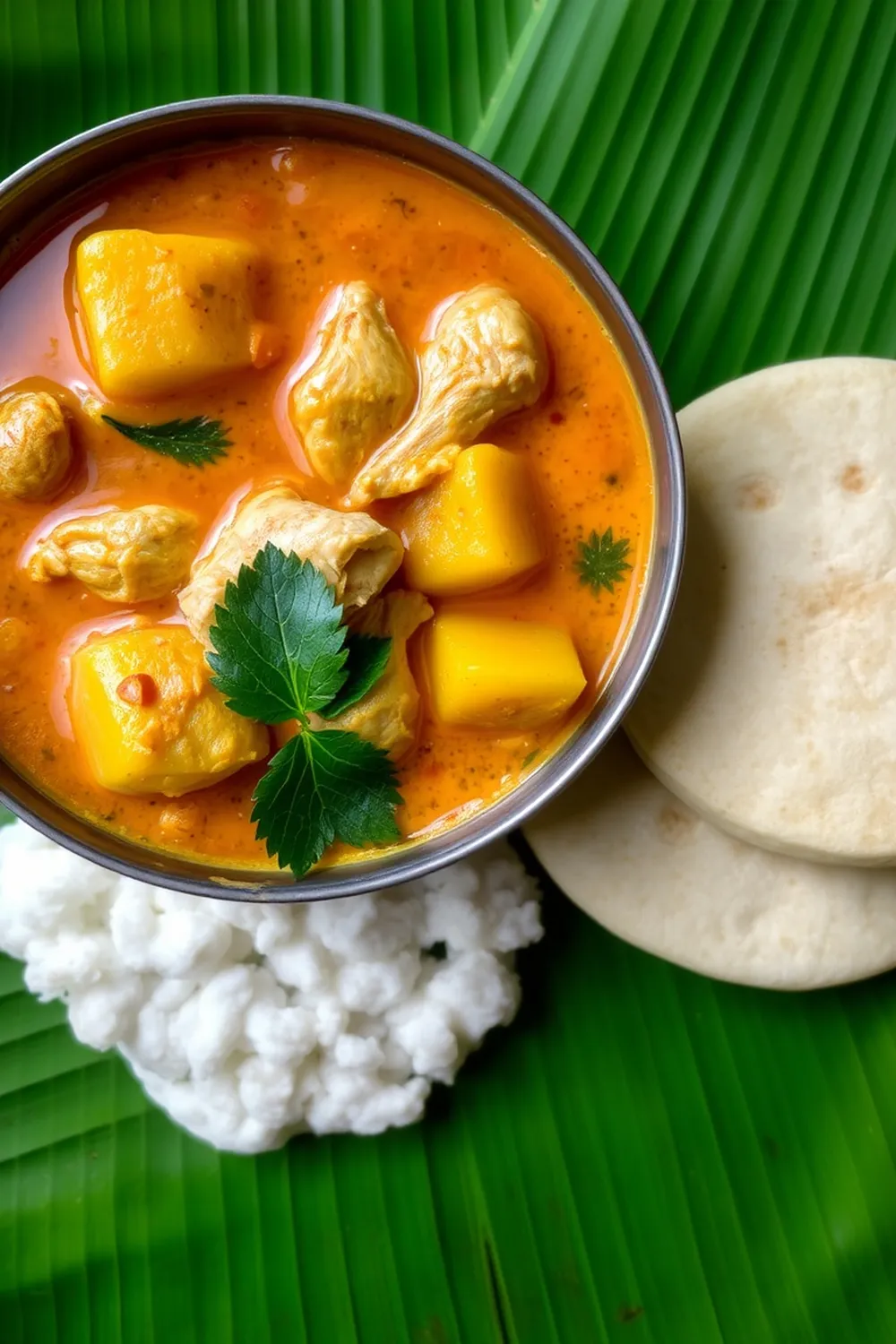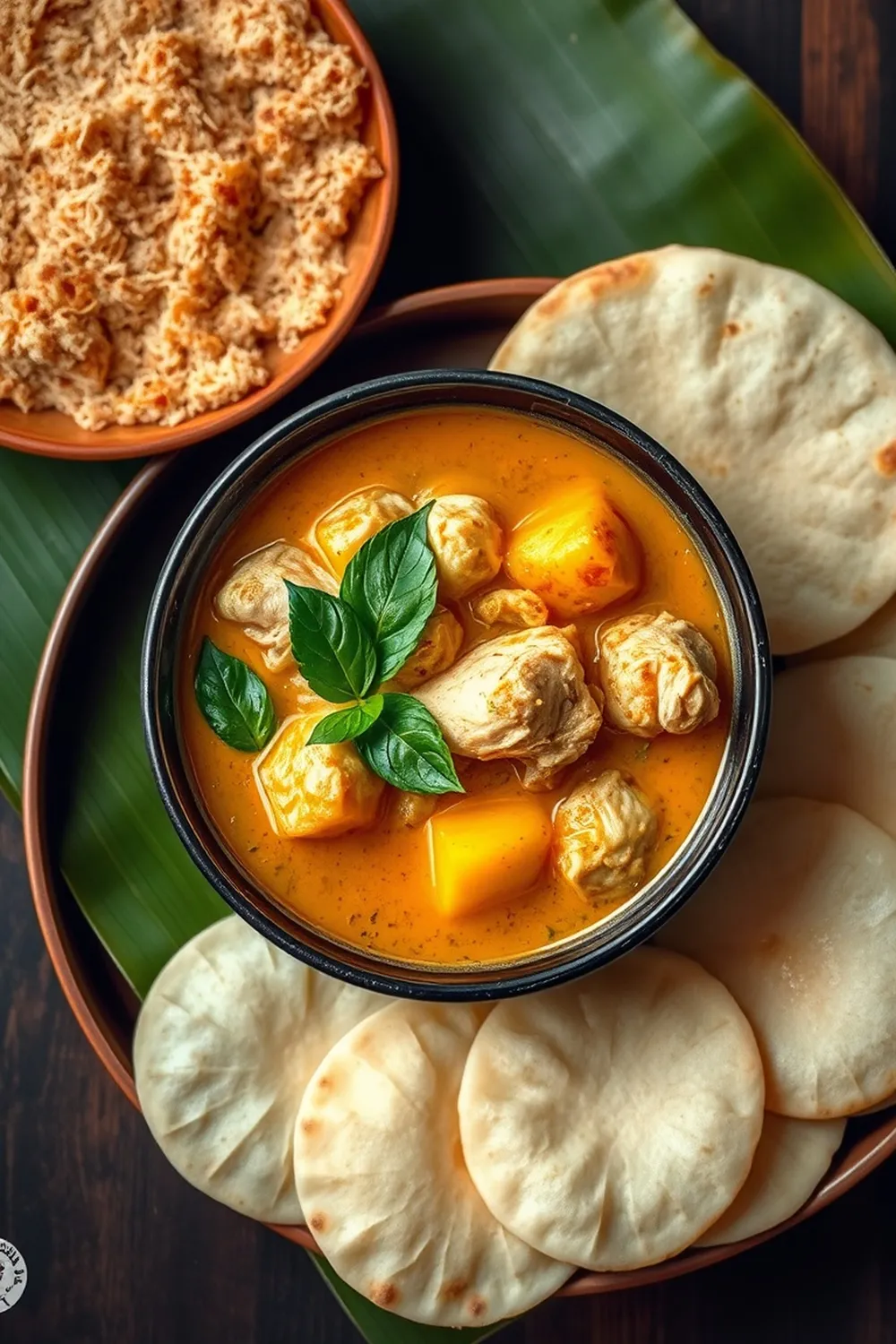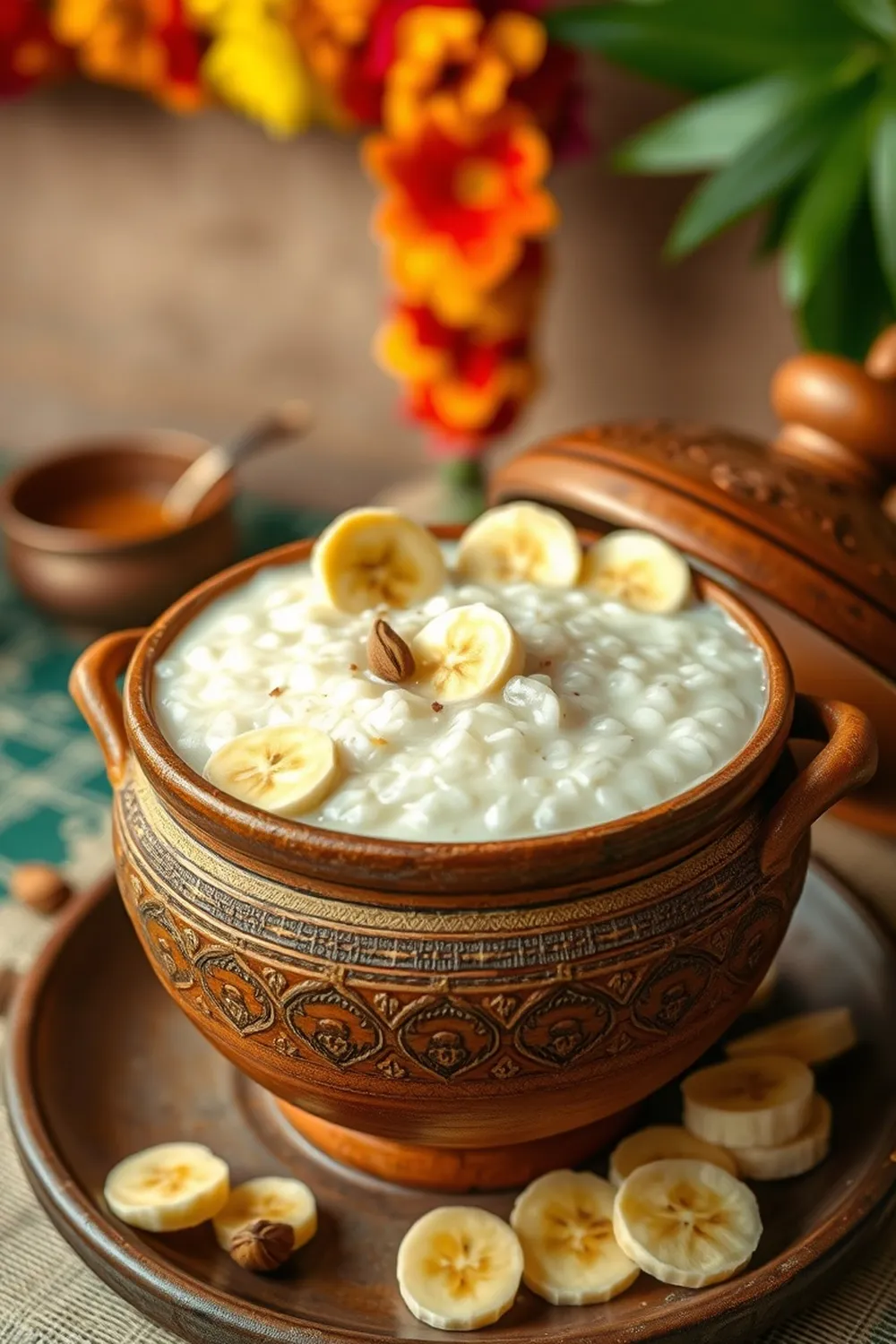- Heat coconut oil in a pressure cooker. Coarsely crush cinnamon, cloves, and black peppercorns. Sauté the spices in the oil.
- Add grated ginger and curry leaves. Sauté for 1 minute until fragrant.
- Add sliced onions and minced green chilies. Cook until onions soften and turn translucent.
- Toss in cubed potatoes. Add chicken pieces, turmeric powder, and black pepper powder. Mix well.
- Pour in thin coconut milk and add salt. Pressure cook for 1 whistle. Allow natural pressure release.
- Stir in thick coconut milk and garam masala powder. Let it sit covered for 2 minutes (do not boil).
- Adjust seasoning if needed. Serve hot with appams or idiyappam.
- Calories:320 kcal25%
- Energy:1338 kJ22%
- Protein:22 g28%
- Carbohydrates:20 mg40%
- Sugar:2 mg8%
- Salt:300 g25%
- Fat:18 g20%
Last Updated on 6 months ago by Neha Deshmukh
Kerala Chicken Curry Recipe – Coconut Milk & Spiced Potatoes
Introduction
Oh, Kerala Chicken Curry. Just the aroma transports me straight back to my grandmother’s kitchen! This isn’t just a recipe; it’s a hug in a bowl. It’s a dish I first attempted (with slightly disastrous results, I’ll admit!) when I was craving a taste of home while living abroad. Now, after years of tweaking and perfecting, I’m so excited to share my version with you. It’s wonderfully fragrant, subtly spiced, and incredibly comforting. Get ready for a flavour explosion!
Why You’ll Love This Recipe
This Kerala Chicken Curry is special for so many reasons. It’s relatively easy to make, even for beginner cooks. The combination of tender chicken, soft potatoes, and a rich coconut milk gravy is simply divine. Plus, the aromatic spices create a depth of flavour that’s truly unforgettable. It’s a dish that’s perfect for a weeknight dinner or a special occasion.
Ingredients
Here’s what you’ll need to create this Kerala masterpiece:
- 2 tbsp coconut oil
- 1 cinnamon stick
- 2-3 cloves
- 1 tsp black peppercorns
- 1 tbsp grated ginger
- 2 sprigs curry leaves
- 1 large onion (sliced)
- 3 green chillies (minced)
- 2 large potatoes (cubed)
- 800 gm chicken (small pieces)
- ¼ tsp turmeric powder
- 1 tbsp black pepper powder
- ¾ cup thin coconut milk
- ¼ cup thick coconut milk
- 1 tsp garam masala powder
- Salt to taste
Ingredient Notes
Let’s talk ingredients! A few little tips can make all the difference.
Coconut Oil: Regional Variations & Health Benefits
Using coconut oil is key to that authentic Kerala flavour. In Kerala, you’ll find different types – some more refined than others. I prefer a good quality, cold-pressed coconut oil for the best flavour and health benefits.
Spices: The Significance of Cinnamon, Cloves & Black Peppercorns in Kerala Cuisine
These aren’t just random spices! They’re the backbone of Kerala cuisine. Cinnamon adds warmth, cloves bring a subtle sweetness, and black peppercorns provide a gentle heat. They’ve been used for centuries in traditional Ayurvedic cooking.
Curry Leaves: Fresh vs. Dried & Their Aromatic Impact
Fresh curry leaves are always best. They have an incredible aroma that dried leaves just can’t replicate. If you can’t find fresh, you can use dried, but use about half the amount.
Coconut Milk: Understanding Thin vs. Thick Coconut Milk
This is important! Thin coconut milk (the first press) is used for cooking the chicken and potatoes, while thick coconut milk (the second press) is added at the end for richness. Don’t skip this step – it makes a huge difference!
Green Chillies: Adjusting Spice Levels to Your Preference
I like a good kick, so I use 3 green chillies. But feel free to adjust the amount to your liking. Removing the seeds will also reduce the heat.
Step-By-Step Instructions
Alright, let’s get cooking!
- Heat the coconut oil in a pressure cooker over medium heat.
- Coarsely crush the cinnamon stick, cloves, and black peppercorns. Add them to the oil and sizzle for about 30 seconds, until fragrant.
- Add the grated ginger and curry leaves. Sauté for about a minute, until you can really smell that beautiful aroma.
- Toss in the sliced onions and minced green chillies. Cook until the onions soften and turn translucent – about 5-7 minutes.
- Add the cubed potatoes and chicken pieces. Sprinkle in the turmeric powder and black pepper powder. Mix everything well, ensuring the chicken and potatoes are coated in the spices.
- Pour in the thin coconut milk and add salt to taste. Close the pressure cooker lid and cook for 1 whistle.
- Allow the pressure to release naturally. This is important – don’t force it!
- Once the pressure is released, open the lid and stir in the thick coconut milk and garam masala powder. Let it sit covered for 2 minutes – don’t boil it! This helps the flavours meld together.
- Adjust the seasoning if needed. Serve hot with appams or idiyappam.
Expert Tips
A few little secrets to make your curry even better!
Achieving the Perfect Spice Blend
Don’t be afraid to experiment with the spices! A pinch of coriander powder or cumin powder can add extra depth.
Ensuring Tender Chicken & Potatoes
Make sure the chicken and potatoes are cut into similar sizes to ensure they cook evenly.
Mastering the Coconut Milk Consistency
If the curry is too thick, add a splash of water. If it’s too thin, simmer it uncovered for a few minutes to reduce the sauce.
Pressure Cooker Safety & Usage
Always follow the manufacturer’s instructions for your pressure cooker. Never overfill it.
Avoiding Overcooking the Curry
The natural pressure release is key to preventing the chicken and potatoes from becoming mushy.
Variations
Want to switch things up? Here are a few ideas!
Vegan Kerala “Chicken” Curry (with Jackfruit or Mushrooms)
Substitute the chicken with 800gm of young jackfruit or mushrooms. The spices will work beautifully with either! My friend, Priya, swears by the jackfruit version.
Gluten-Free Adaptations
This recipe is naturally gluten-free! Just double-check that your garam masala powder doesn’t contain any gluten-containing ingredients.
Spice Level Adjustments: Mild, Medium, & Hot
* Mild: Use 1 green chilli and remove the seeds.
* Medium: Use 2 green chillies.
* Hot: Use 3-4 green chillies and leave the seeds in.
Kerala Chicken Curry for Onam/Christmas Celebrations
This curry is a staple during Onam and Christmas in Kerala. It’s often served as part of a larger feast.
Serving Suggestions
What goes best with this flavourful curry?
Traditional Accompaniments: Appam, Idiyappam, Rice
Appam (lace-edged pancakes) and idiyappam (string hoppers) are the classic accompaniments. Steamed rice is also a great option.
Side Dishes to Complement the Curry
A simple vegetable thoran (stir-fry) or a cooling raita (yogurt dip) would be perfect.
Drinks to Pair With Kerala Chicken Curry
A glass of cool buttermilk or a refreshing mango lassi would balance the spice beautifully.
Storage Instructions
Got leftovers? No problem!
Refrigerating Leftovers
Store leftover curry in an airtight container in the refrigerator for up to 3 days.
Freezing Kerala Chicken Curry
You can freeze this curry for up to 2 months. Thaw it overnight in the refrigerator before reheating.
Reheating Instructions
Reheat the curry gently over medium heat, stirring occasionally. Add a splash of water if it’s too thick.
FAQs
Got questions? I’ve got answers!
What type of chicken is best for this Kerala curry?
Bone-in, skin-on chicken pieces are ideal for flavour, but boneless, skinless chicken thighs also work well.
Can I use store-bought curry paste instead of individual spices?
While you can, the flavour won’t be quite the same. Using individual spices allows you to control the flavour and aroma.
How can I adjust the thickness of the curry?
Add water to thin it out, or simmer uncovered to reduce it.
What if I don’t have a pressure cooker? Can I use a pot?
Yes, you can! Cook the curry in a heavy-bottomed pot over low heat for about 45-60 minutes, or until the chicken and potatoes are tender.
Is it possible to make this curry ahead of time?
Absolutely! The flavours actually develop even more overnight.
What is the best way to balance the flavors in this curry?
Taste as you go and adjust the salt, spice, and acidity (a squeeze of lime juice can help) to your liking.
Neha Deshmukh
Neha holds a B.A. in History with a focus on Indian and world history, including ancient, medieval, and modern periods. At RecipesOfIndia.org — the world’s largest database of Indian recipes — she combines her love for food and history by exploring how India’s past has shaped its culinary traditions.










